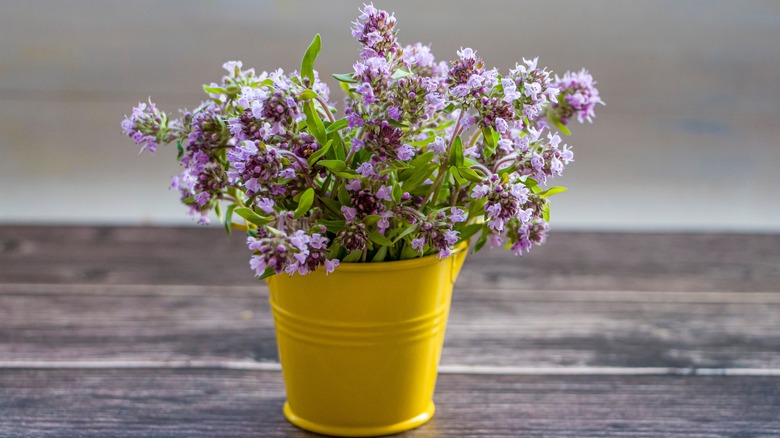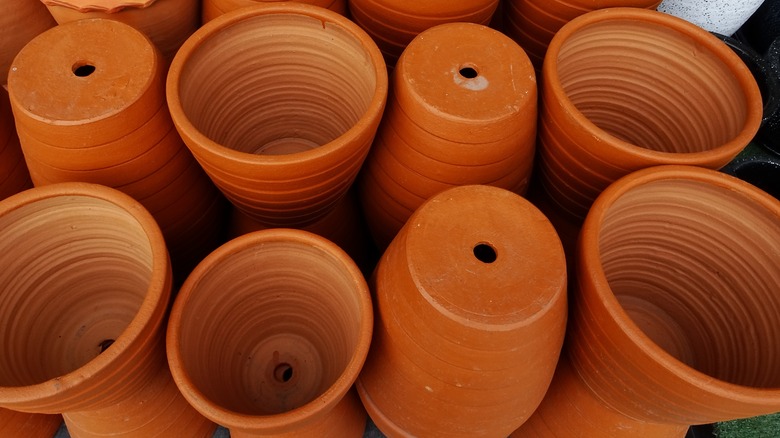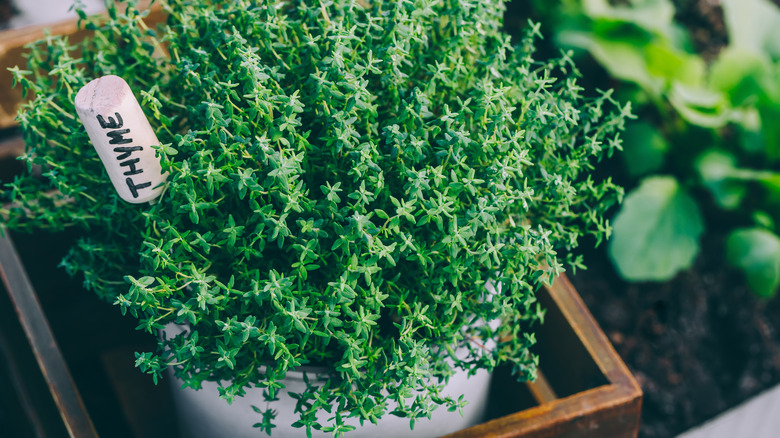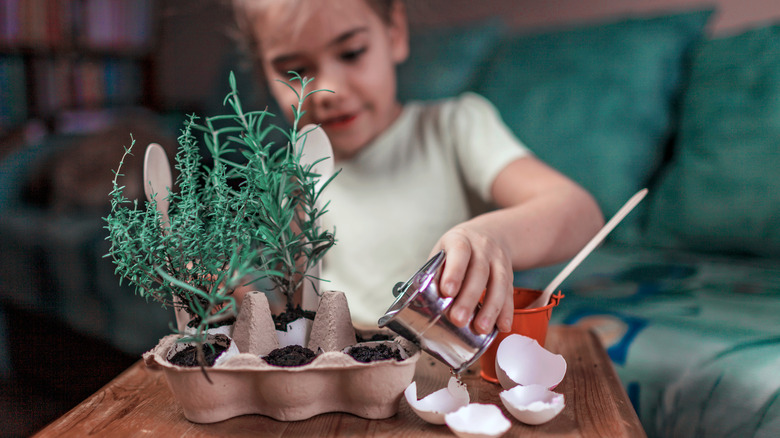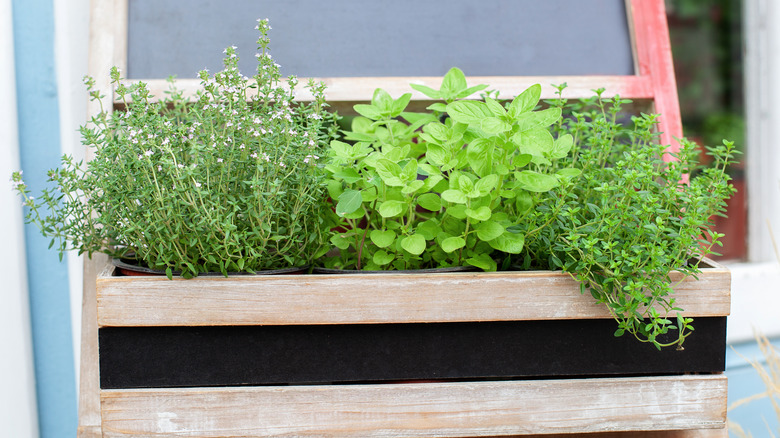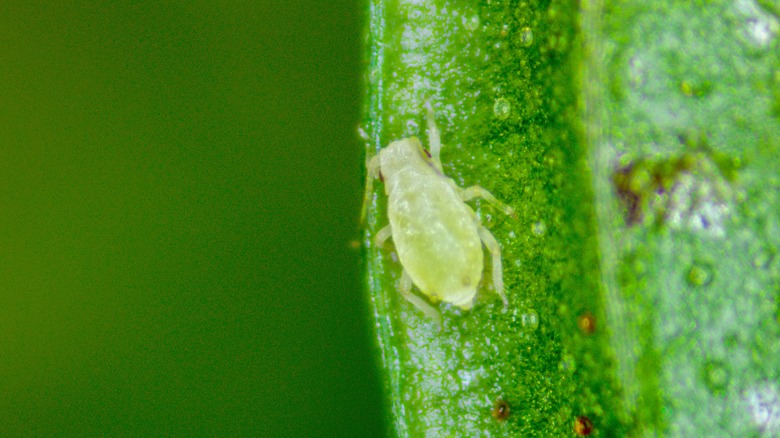5 Tips For Caring For Your Thyme Plant Indoors
Thyme is a culinary mainstay that you'll find in just about every kitchen. This herb, which is a close relative of the mint plant, according to the North Carolina Extension Gardener, comes in handy for flavoring poultry, stews, pork, and sauces. So, you can see why it would be an excellent addition to an indoor herb garden or in a planter by itself. In addition, the North Carolina Extension Gardener notes that thyme is relatively easy to cultivate. It requires minimal watering and grows best in rocky soil. Moreover, disease and pests shouldn't pose major issues, especially if you keep your plant well drained and exposed to sunlight.
Plus, figuring out when to trim thyme is not difficult. You simply crop it when it starts to branch out and make sure to cut the leaves before the plant starts to blossom. This preserves the herb's flavor. Wondering how else you can make your thyme plant thrive? Here are five tips for keeping it in top shape.
1. Find the perfect container
For thyme, just like any other herb, you will need to find an ideal container that allows your plant to drain well. At the same time, you can always poke or drill holes in the bottom of the pot if it doesn't already come with drainage openings. Still, when it comes to finding the right pot, there are other factors to keep in mind as well, according to Integris Health.
Clay or ceramic containers work well for herbs, in general, but plastic is also a good choice. Clay or terracotta pots tend to be porous, thus allowing for the soil to air-dry more quickly, whereas ceramic containers keep moisture in for a longer period. Plastic is also more conducive for plants that love moisture, but you may want to avoid metal containers in spite of their aesthetic appeal because they cause the soil to dry out too quickly due to heat retention. But, again, no matter which material you go for, make sure it has proper drainage.
2. Drain thoroughly
While your plant's container may have enough holes to allow water to pass through, there are other protective measures to ensure adequate drainage. As mentioned by Love the Garden, you can enhance your thyme's drainage process by adding crushed quartz, sandstone, or granite (which is known as grit) to the soil. Including a small amount of grit reduces water retention and prevents the roots from drowning per MasterClass. You can also mix some compost with the soil, which has the same effect. Adding either of these components won't harm the roots or the pH level: Basically, you are keeping the water from stagnating in the soil and subsequently causing root rot or other issues related to retaining too much moisture.
However, if you are concerned about the thyme drying out too quickly due to the atmosphere in the room, you do not have to worry about this since this plant is drought resistant. Still, you can take a spray bottle filled with water and gently mist the leaves or place the plant's container on top of a tray filled with small pebbles and some water which will add humidity to the air, as mentioned by Home Depot.
3. Repot as needed
Thyme tends to spread out as it matures, so repotting once a year, at least, is advisable, The Kitchen Herbs notes. The most obvious sign that tells you it is time to repot relates to the roots. When they start growing out of the drainage holes, you need to move the plant — the sooner, the better.
You can approach repotting in one of two ways. The first is to move the whole herb from its current pot to a new, larger one with a similar soil mixture. The other method — which may be ideal, according to The Kitchen Herbs, since it helps the plant grow fairly quickly — is to divide the thyme into smaller parts. This is done by digging up the entire plant and gently pulling apart three to four portions. You'll then transplant each portion into its own pot, GrowVeg explains. Finally, to decrease any water loss that may occur, you can cut back about half of the herb's leaves.
4. Allow for adequate sun
According to the Almanac, thyme requires full sun. Plus, it thrives even more when placed in a well-heated area. As noted by PH&G, exposing thyme to sunlight maintains the health of the roots by warding off rot. You can possibly get away with keeping your plant in partial shade if the sun doesn't shine into the room for part of the day. However, placing it in full sun for six to 10 hours would be best. This means finding a window sill or another spot in your home that receives as much natural light as possible.
Another tip is to move your plant to a different room throughout the day if possible, but during the winter, if you live in a cold weather climate, you'll need to remember to keep your pot away from the window sill if the area feels cold. Thyme does not really tolerate temperatures below 60 degrees Fahrenheit.
5. Watch for pests
According to Planet Natural Research Center, root rot, also known as botrytis rot, would be your biggest worry since the roots of thyme plants can't stand in moisture for great lengths of time. Overall, optimal conditions like the proper room temperature, plenty of sun, and adequate air circulation prevent root rot from settling in, so you need to first be wary of those.
Unfortunately, caring for your thyme plant indoors doesn't mean it will be immune to invading pests. You still need to watch out for aphids, which love to feed upon new growth underneath the leaves, and fungus gnats (per Planet Natural Research Center). You'll also need to be mindful of spider mites. To prevent infestation or kill off pests that have invaded your thyme, spray the plant carefully with neem oil, an organic pesticide that's harmless to humans. A mix of dish soap and water also keeps bugs, as well as fungi, away.
